Leaving where I left off with my Five Points adventure, across the street from Chatham Square and indeed stretching out from it along East Broadway is Chinatown. At Chatham Square is another little square called the Kim Lau Square. Within
that square is a statue dedicated in 1997 to Lin Ze Xu, a Chinese diplomat who was born in Fuzhou in 1795. (Ch. 179) The statue base reads "A Pioneer in the War Against Drugs" for his involvement with the First Opium War. In 1838, when the emperor of China sent Lin to Guangdong, Lin immediately banned the sale of opium, impounded the drug from British vessels and wrote a nasty letter to Queen Victoria. (Ch. 179) Obviously, that didn't go over well. And the First Opium War had begun.
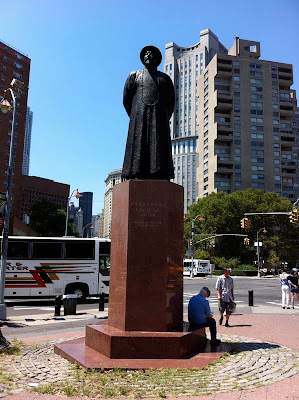 |
| Statue of Lin Ze Xu |
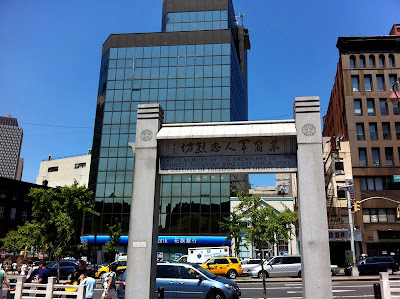 |
| Tight concentration of memorials! |
 |
| Everything was moving... |
 |
I'm shocked that
the health dept. is cool with this. |
The fact he's from Fuzhou is important because in Manhattan, the largest and the fastest-growing segment of the immigrant population is in Chinatown, where most people hail from Fuijian. The statue "gazes down east broadway towards the heart of the Fujianese neighborhood". (Ch. 179) Indeed, when I got off the subway at Stillwell Avenue, I felt like I had just landed in another country. There were strange smells and sights and LOTS of people. I mean, LOTS AND LOTS of people. It was actually the first time in NYC that I felt claustrophobic. After eating dim sum, Carin and I wandered around Chinatown not only to see the sights I had planned out but also to experience Chinatown. We experienced with all our senses. There was this little sweet shop that had all sorts of interesting dried fruits and dried fish and candy. It was like a catchall and everything was in bins with samples on the top. I tried most things (unless it looked like it could be mango) and a few times was absolutely disgusted by what I put in my mouth! We also went into some markets and saw LIVE shrimp, crab, prawns, etc. We also discovered
longan fruit, which is surprisingly hard to understand someone saying. It took several attempts, and I think the purveyor just took pity on us and gave us a sample. It was quite tasty (and a little exciting - I had no idea if I would be allergic to this too (don't worry, Mom, I had my epi pen)).
 |
Nom Wah Tea Parlor shown in this picture is
Chinatown's oldest dim sum parlor, opened in 1920 |
Next on the agenda was the "Bloody Angle" (aka "The Most Dangerous Place in America") of Doyers Street. (Ch. 141) Honestly, when I looked at the street, I thought it might be the most dangerous place because it's a road that turns at a sharp angle (think any small street in Europe) and I was picturing the All State guy saying this is where the most accidents happen. Well, I was wrong. In 1910, police started a campaign to "clean up" Chinatown. They warned white women from going to noodle restaurants with Asian men because it would be assumed they were prostitutes! They also asked tour companies to stop taking white people on late-night
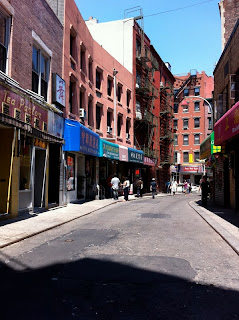
excursions to Chinatown. (Ch.141) Side note: What is with the people in NYC in the mid-1800s to early 1900s!?!
Tours to slummy neighborhoods?!
Anyway, this street got its name because Chinese gangs (the Hip Sing tong and On Leong tong, specifically) would often meet up here for their fights. The police declared that more murders happened on Doyers than anywhere else in America (based on their expert knowledge of such things). (Ch. 141) Today, it looks rather innocuous and apparently is good feng shui (the curve in the road confuses evil spirits). (Ch. 141)
In the heart of Chinatown is what was originally a Lutheran church that turned Episcopalian but ultimately became Catholic church, having been purchased in 1853 by the Catholic archdiocese. (Ch. 64) The Church of the Transfiguration was built in 1801, which makes it the third oldest church in NYC. (Ch. 64) At the time, Irish Catholics had come to NYC in such numbers that it was the second-largest Irish city in the world (second to Dublin, of course). (Ch. 64) It was strange to see this very anglo-church (anglo meaning protestant or catholic) in the middle of a sea of Chinese letterings on buildings. It's definitely a testament to the way things change.


Across the street from the Church of the Transfiguration, is 32 Mott Street, which the book says is one of the oldest shops in the heart of Chinatown. (p. 308) According to the book when the first Chinese settled on Mott Street, it was the center of a thriving Irish community (hence the church with almost 20,000 parishioners by 1860). (Ch. 87) I actually didn't know this but it was the completion of the cross-country railroad in 1869 that sparked a Chinese migration from the west to New York. (Ch. 87) Upon thinking about it, that makes
complete sense. On the other hand, Europeans now had access to the west coast. It was also during this time that the Chinese Exclusion Act was promulgated in Congress, which meant that those Chinese people who wanted to stay in the U.S. could never leave. The book says that this is what led to the phenomenon of Chinatowns -- people creating some semblance of the life back home because they could never return. (Ch. 87) I guess that makes sense too.
 |
| Street of Chinatown (Mott Street, specifically) |
 |
| The oldest Chinatown shop. |
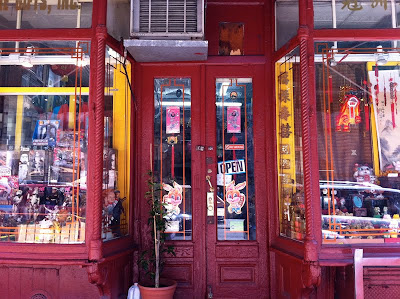 |
| So fun!! |
We also visited Columbus Park which was right by the Five Points intersection. It was named Mulberry Bend Park until it was renamed for Columbus in 1911. (Ch. 105) The blocks surrounding the park were condemned, dispossessing about 2,500 people, who likely moved to Hell's Kitchen). (Ch. 105) It was established to act as a positive influence on the youths of the area. (Ch. 105) It's now a huge gathering area for Chinatown. Carin and I enjoyed seeing the elderly men play dominoes and the women gather to listen to another woman sing/ tell stories. It was a very active Sunday in the pa
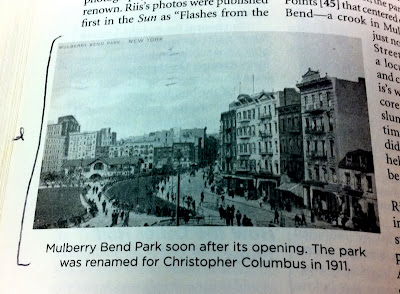 |
| Mulberry Bend Park from the book. |
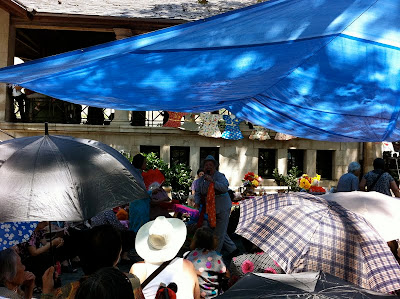 |
You can still see the building in the above picture (that's what behind this blue tent).
Carin and I couldn't figure out why ALL the women were in this group and watching this woman. |
 |
This definitely seemed like the kind of place where people
just came and relaxed/ spent time together on a Sunday. So nice. |
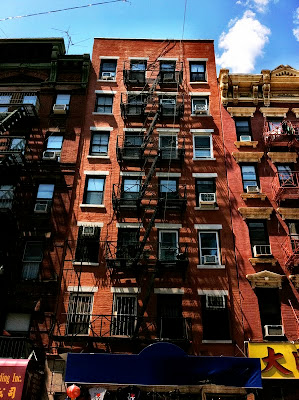 |
| 65 Mott Street |
Lastly, a description about Chinatown would not be complete without describing the tenement buildings. The first tenement in NYC is at 65 Mott Street. (Ch. 32) From the description in the book, I imagine that living in these buildings is similar to what the Irish immigrants in
Far & Away (ignoring that it was set in Boston) faced (from what I remember of it anyway -- it's been a long time!). In 1824, to help combat the growing poor popular problem, a developer came up with the idea of growth upward instead of outward. (Ch. 32) There were 2 apartments on each floor: a front apartment with parlor, living room, and 2 bedrooms, and an identical rear apartment overlooking the outhouses. (Ch. 32) However, tenements after this came to usually have 4 apartments on a floor and no natural light could penetrate the back bedrooms. (Ch. 32) Fortunately, new laws in 1867 and then again in 1901, improved tenement living. (Ch. 84) The 1901 law mandated enlarged airshafts (so there would be a window in every room), running water and bathrooms in
every apartment. (Ch. 84) These tenements were soon replaced in the 1930s by the city's new preferred mode of low-cost housing -- housing projects. (Ch. 84)
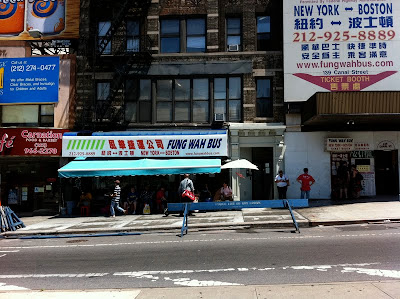 |
The Fung Wah bus.
It's the cheapest way to get to Boston (even cheaper than the Bolt Bus!).
Although that cheap-ness comes at a price. I will say that my bus experience
included sitting between an obese woman and a European woman with a
cat in a carrier... oh, and no A/C/! 5th circle of hell, anyone?!?1 |
No comments:
Post a Comment